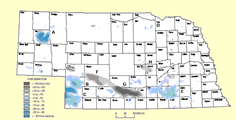Natural Resources, School of
Document Type
Article
Date of this Version
5-1969
Citation
Elder, J. A., 1969. Soils of Nebraska. Conservation and Survey Division, University of Nebraska. pp. 60.
Soils of Nebraska Elder 1969.pdf (30432 kB)
Non-OCR'ed version (30 Mb)
Non-OCR'ed version (30 Mb)
Included in
Geology Commons, Geomorphology Commons, Hydrology Commons, Paleontology Commons, Sedimentology Commons, Soil Science Commons, Stratigraphy Commons


Comments
RR-2
Nebraska's growth and development are directly related to an abundance of soils of high natural fertility and a citizenry who retain the pioneering attributes of adaptability and innovation. Large areas of the state have soils that are well suited to producing cultivated crops. Some of the soils are poorly suited to growing cultivated crops but well suited for use as grazing and hayland. Nebraska agriculture is young in years of development and we are still attempting to correct some of the errors made in selecting and altering the land to be used for cultivated crops. More recently, the widespread development of irrigation has opened a new frontier in agricultural development, and the practices of using commercial fertili zers to enrich the soil and chemicals to control weeds and insects are now applied to large areas of our agricultural land. The effect, however, of the continued use of these chemical additives on the soil environment is not known. The knowledge and experience gained from a century of dryland farming are outmoded and we must accelerate our research and studies of the changing agricultural technology. Also, the expansion of urban and industrial areas presents problems and the promise of future problems. The solution of these problems will require the interest and cooperation of many people. Research must study and analyze the effect of the changes in agricultural management and use of our soils. The public must be advised of the information gained from these studies. The agricultural community must recognize and attempt to minimize the problems and pitfalls associated with agricultural development. Home owners, urban planners, real estate developers, and others engaged in planning the use of nonagricultural lands and soils, all have a responsibility to their communities to recognize the potential and, in some cases, the limitations imposed by the soils on the developments and actions that are contemplated. The information in this bulletin has been assembled for the use of those who are interested in the soils of Nebraska so that they can better understand and participate in the solution of the problems that relate to soils. The soil association map shows the distribution and extent of the soils and the text, diagrams, and charts give the characteristics, relationship, and general properties of the soils. The county soil survey reports should be consulted when more detailed information is desired. A list of the published soil survey reports appears on page 60.